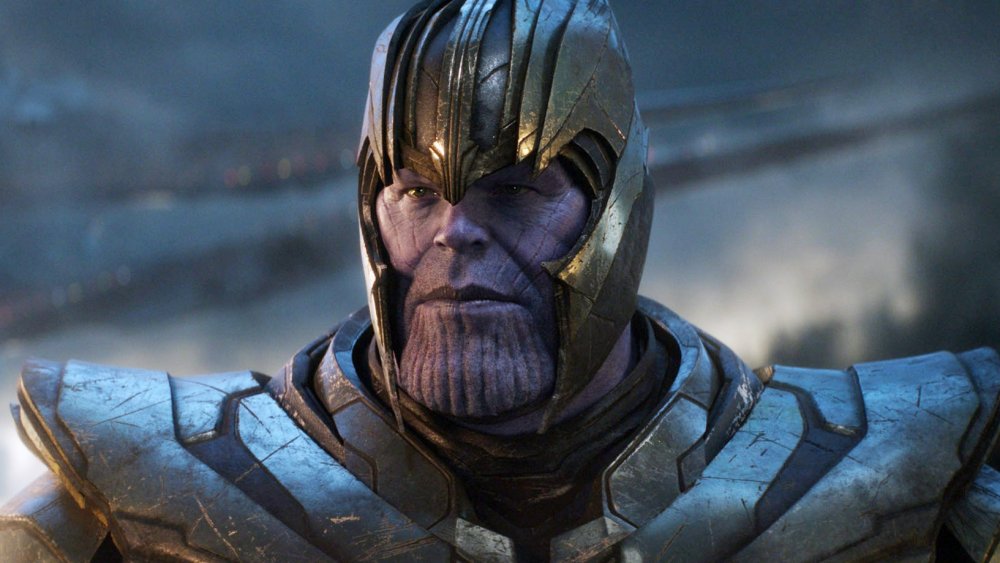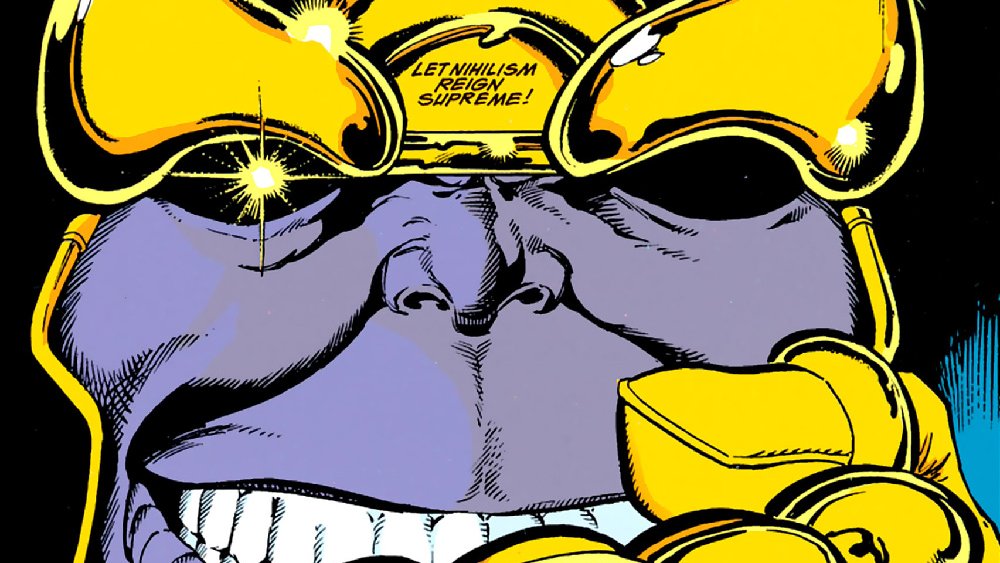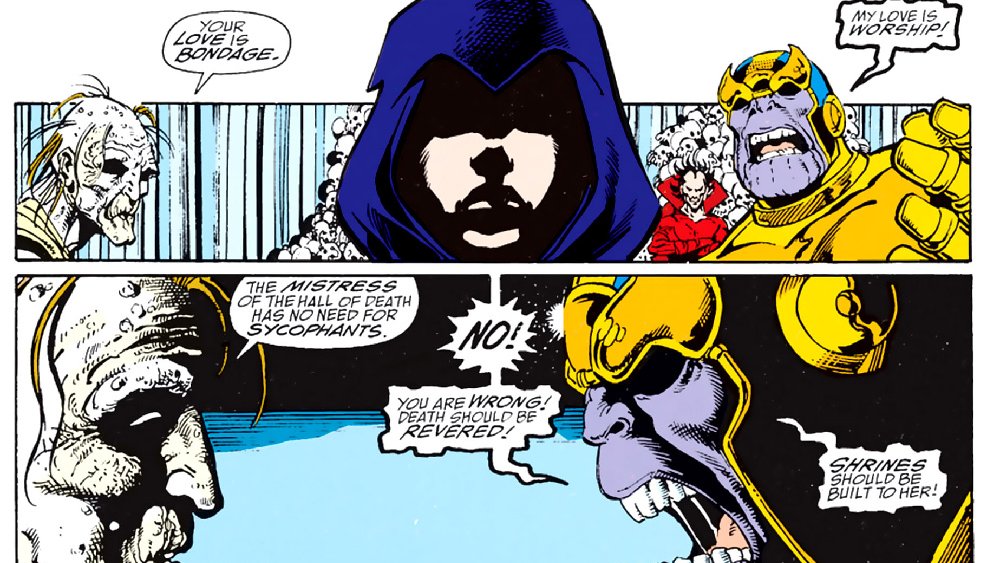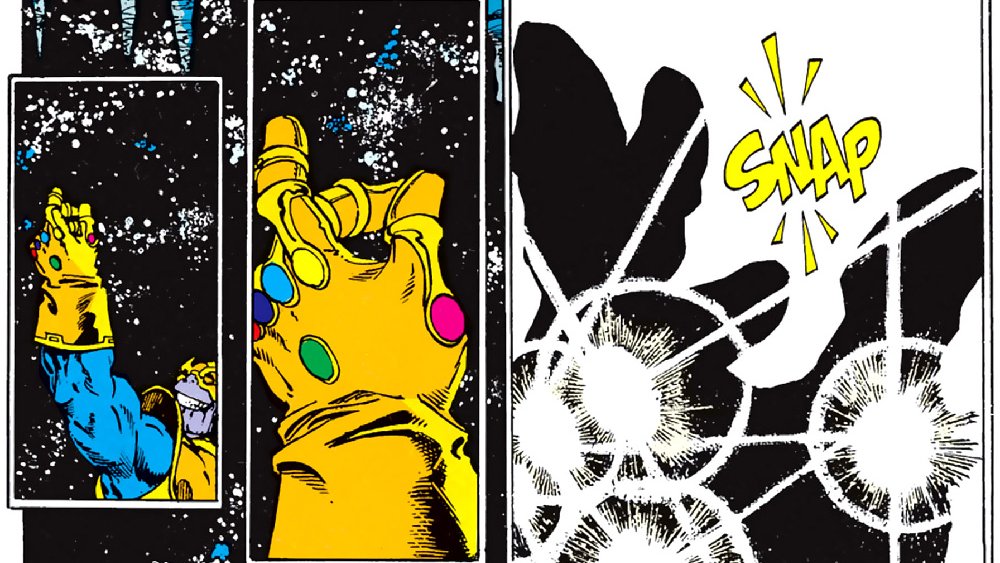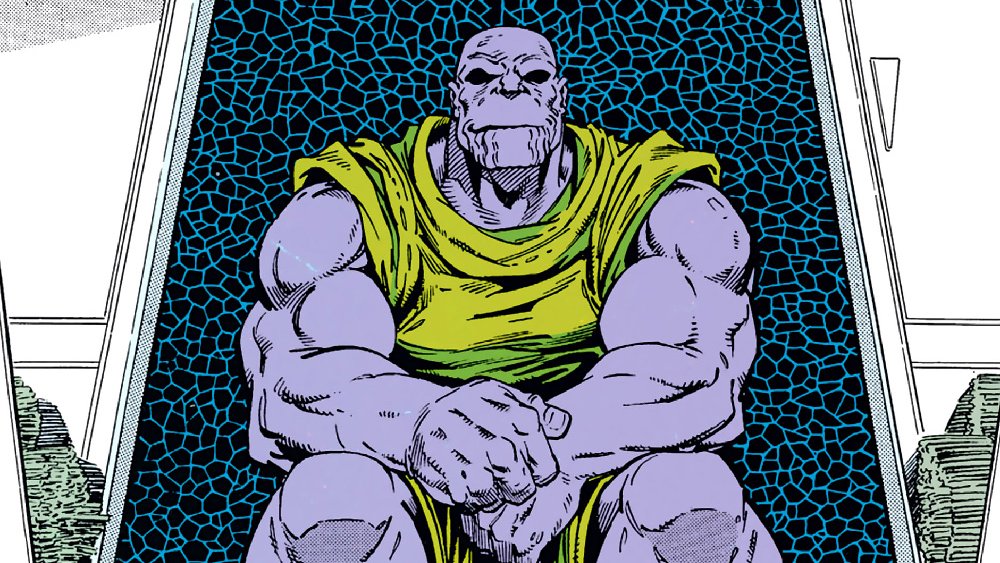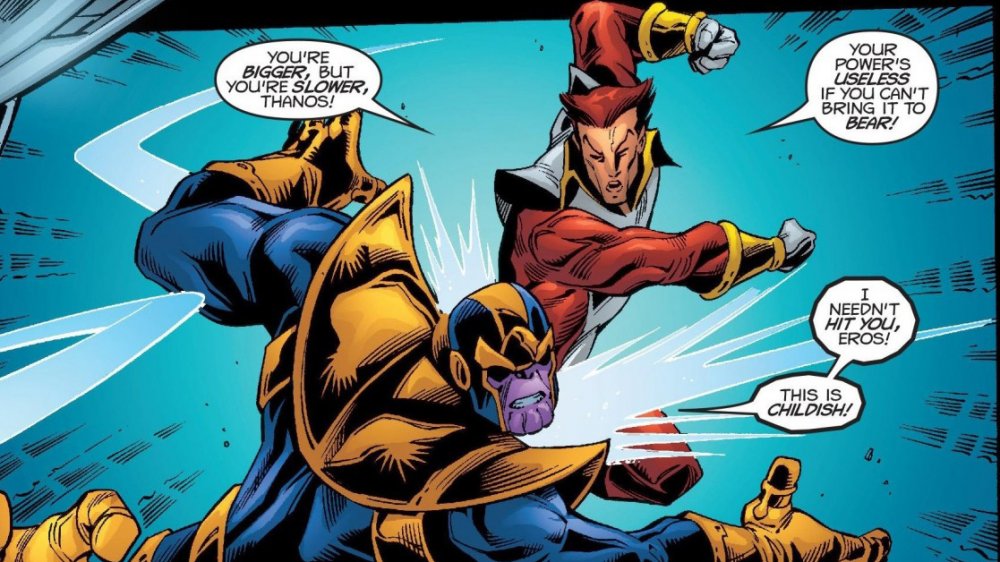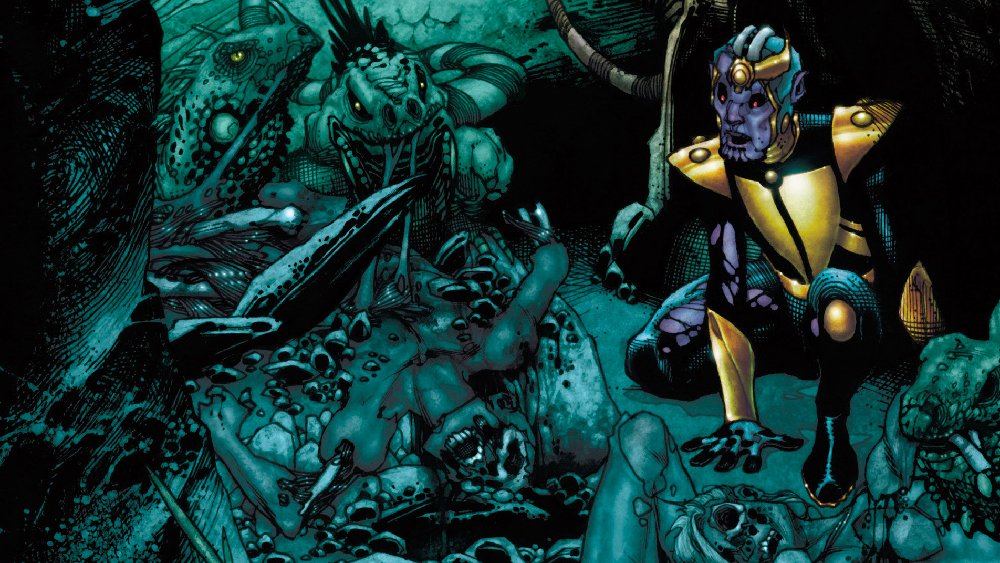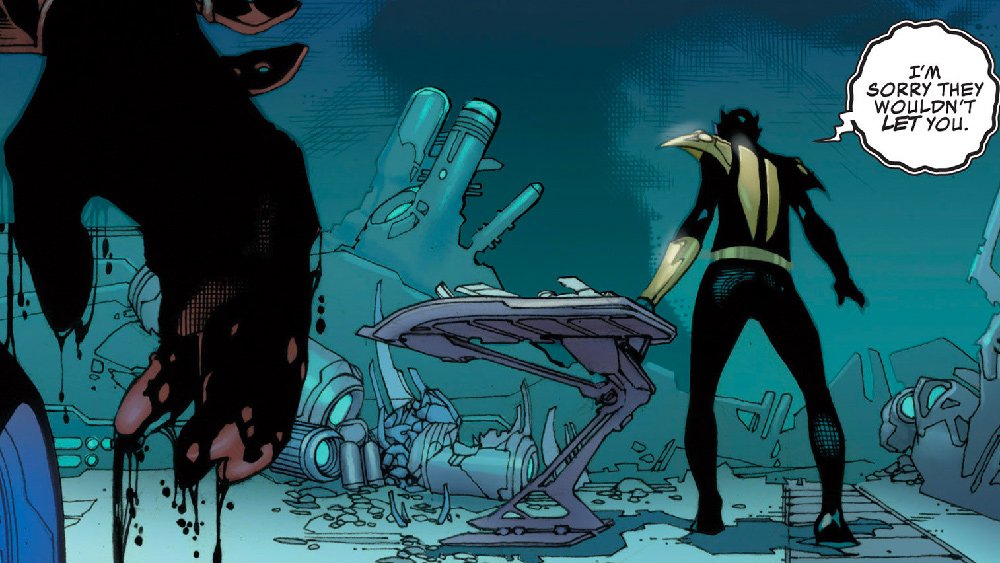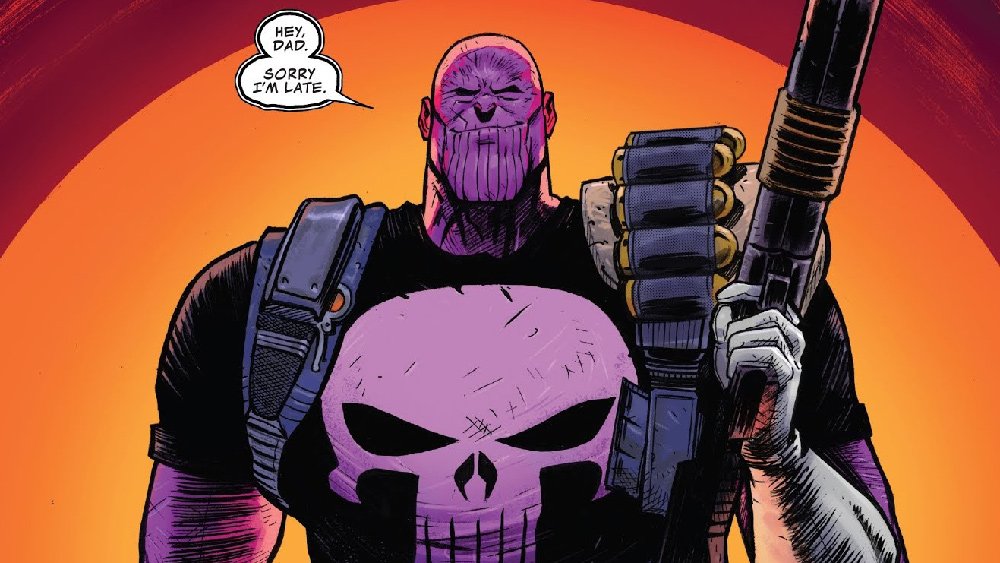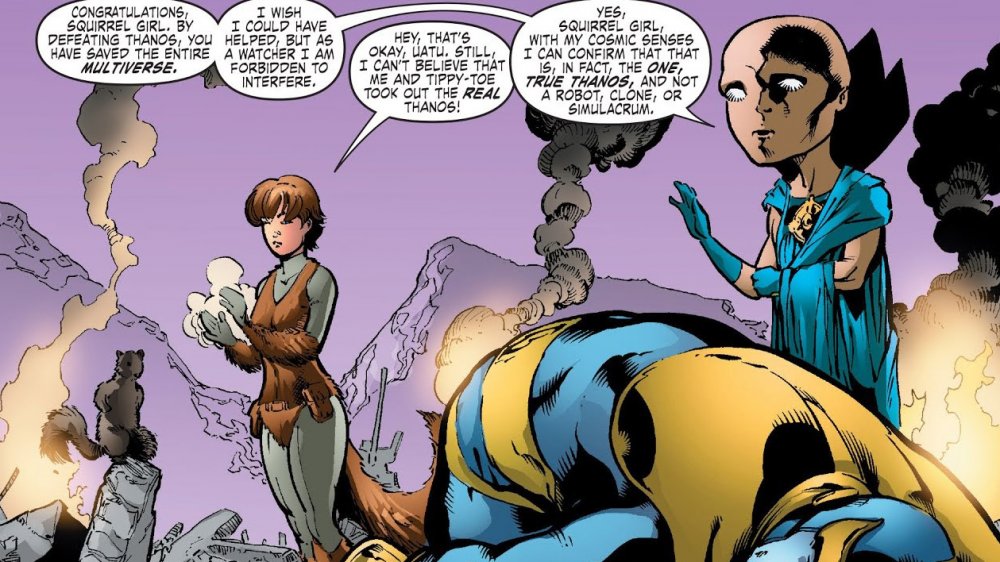Things About Thanos That Didn't Make It Into The MCU
When the Marvel Cinematic Universe needed a villain who could threaten the entirety of creation, Thanos was the obvious choice. The Mad Titan has, after all, been terrorizing the comics for almost 50 years, and he was at the center of some of the biggest cosmic conflicts in the company's history. He's unrepentantly evil, world-shatteringly powerful, and commands a small army of super-powered henchmen to do his bidding across the universe. In other words, he's the perfect big bad for a story that spanned 11 years and two dozen movies.
Well, almost perfect. Like a lot of characters, Thanos underwent a few changes in his transition from the page to the screen. While comics fans were delighted to see the Avengers fighting a giant purple spaceman with a glove made from magic space rocks, there's plenty of complex continuity and character motivation that just didn't make the cut. If you only know Thanos from the big screen, you're missing out on a few big puzzle pieces, but don't worry. We're here to bring you the things about Thanos that didn't make it to the MCU.
Thanos is a nihilist in the comics
In the MCU, Thanos is motivated in his mission of galactic genocide by an obsession with balance. It's the cause that makes him believe that for all of the horrors he's perpetrating, he's actually doing something noble and good, preventing the misery he experienced on his own home planet that came from overpopulation and strained resources. It's a pretty flawed belief, but he believes it to the very core of his being. Believe it or not, that's a pretty big departure from his comic book counterpart, who believes in ... nothing.
In several comics, including those written by his creator, Jim Starlin, Thanos is frequently referred to as "the ultimate nihilist." For those of you who slept through your early morning philosophy class, nihilism is a philosophical movement that picked up in the 19th and 20th centuries that, in its most basic form, states that nothing really exists or matters. It can be applied to different branches of philosophy, but it most commonly refers to existential nihilism (the belief that there's no intrinsic meaning or significance to life) or moral nihilism (the belief that one's actions are completely devoid of ethical value). In that view, doing something like, say, interplanetary mass murder is neither good nor evil. It simply is, with no more moral weight than eating a peanut butter sandwich or petting a dog.
That's what makes the Thanos of the comics such a compelling and frightening villain, especially when he's pit against superheroes, who almost universally represent the idea that one's abilities and actions do have meaning and consequence. Or, to put it another way, they have great power and, because of it, great responsibility. For Thanos, that responsibility just doesn't exist. He's not fighting the heroes because he hates them, he's fighting them because there's no reason not to. He's not trying to complete the Infinity Gauntlet because he wants to control the universe, but because attaining absolute control over reality is the only way to do literally anything that matters at all.
The whole 'loving Death' angle didn't make it into the MCU
For all of our cheerful talk of nihilism and the futility of existence, it's worth noting that the Thanos of the comics page isn't entirely without motivation. It's not a dedication to balance, though, or a twisted attempt to correct the suffering of his past. It's that Thanos just straight-up wants to get his bone on, in a very literal sense.
In the comics, Thanos is in love with Death — not the concept, per se, but the lady-shaped embodiment thereof. See, in the Marvel Universe, most fundamental concepts — stuff like Order, Chaos, Love, Hate, Eternity, and so on — exist both as abstract ideas and as beings with physical forms. Death is one of those, and apparently, her physical form is very appealing to Thanos, despite the fact that she's usually represented as a skeleton in a shapeless hooded gown and only occasionally has things that most of us would find attractive, like skin or eyeballs.
After meeting Death as a thirsty teen, Thanos decided that the best way to impress her would be to kill as many living beings as possible, giving countless souls to her in the nihilistic cosmic equivalent of subscribing to her OnlyFans. Unsurprisingly, this didn't really work that well because, you know, she's Death, and giving her dead people is sort of like giving a heart-shaped box of chocolates to Willy Wonka. Despite taking a keen interest in Thanos and his exploits, Death remains distant, and she's actually way more DTF for Deadpool, with whom she shacks up during his brief periods of being dead while his healing factor stitches his body back together. No joke. The Thanos/Deadpool/Death love triangle is 100% canon.
Doing things by half
If you're in the roughly 100% of people living on the planet Earth who saw Avengers: Infinity War, you know the Mad Titan's ultimate goal after assembling all six of the Infinity Stones is to wipe out half of the sentient life in the universe with a single snap of his fingers. This actually is something that was brought to the screen directly from the comics. What didn't make it was the context.
On the screen, the end of billions of billions of lives across the galaxy is what Thanos has been working towards for ten years. It's the culmination of his plan, the end that has justified all his horrendous means. But in the comics, it's just his opening act. Halfway through 1991's The Infinity Gauntlet #1 — not even the climax of the first issue — Thanos attempts to prove both his incredible power and his devotion to Death by killing half the universe with a snap of his fingers. It's meant to be a chilling depiction of how powerful he's become, that such a massive act can happen just like that. Of course, it also has the benefit of keeping the cast at a manageable size and getting rid of problematic characters like Daredevil (who wouldn't fit with the cosmic action) and the Fantastic Four (who have experience trouncing unfathomable cosmic forces).
It's definitely one of the most memorable moments of the story, although removing it from that context gives the movies' Infinity Saga one of its weirdest little quirks. In the comics, the snapping of fingers is meant to illustrate how effortless it is. In the movie, it's something you have to do in order to use the Stones, something that has the biggest ratio of inherent silliness to serious presentation in the entire franchise. Forget about the head, Thor should've aimed for the thumbs.
A simple kind of Mad TItan
One of the biggest moment that was brought to the screen without its original context is the one we see at the end of both Infinity Gauntlet and Infinity War — Thanos retiring to his farm to live out the rest of his days in peace, working the land and living a simple life.
While the actions of the two scenes are the same, the meaning of them couldn't be more different. In the film, this peaceful, pastoral setting is the reward Thanos gives himself for a job well done. In the comic, it's a very different scene. When we see Thanos on the farm in Infinity Gauntlet, it's after he seemingly blows himself up with a thermonuclear bomb, refusing to accept his defeat at the hands of the heroes. His life on the farm is meant to represent a change — he's a Very Bad Guy, but thanks to some time-reversing shenanigans, all the bad things he did over the course of the story never actually happened. What did happen was his utter defeat, a failure that he brought on himself despite literally having omnipotence at his fingertips. The scene on the quiet farm is meant to be Thanos learning from that defeat and deciding that his life up to now has been, to put it mildly, very misguided.
That's what's lost in the translation, a redemption of sorts. In the movies, Thanos is an irredeemable monster hell-bent on death and destruction, which works just fine. In the comics, where there's a lot more room to explore these things, he's a slightly more complex character. Of course, that redemption doesn't really stick because having a lot more room to explore these things also means that villains are gonna villain.
Thanos' bizarre family tree
In the films, Thanos is a singular being, unique in the universe, with his only family being his adopted "daughters," Gamora and Nebula, who he abducted and turned into ruthless killers to further his goals. In the comics, Gamora and Nebula are still there and have essentially the same relationship — although he treats Nebula even worse on the page, if you can believe it — but they're far from the only relatives Thanos has. He's got a whole family, including two Avengers.
Since he's often referred to as "the Mad Titan," it's easy to guess that Thanos hails from, uh, Titan, one of Saturn's many moons. In the distant past, Titan was colonized by the immortals known as the Eternals. These Eternals, hyper-evolved humans who were experimented on by a bunch of space gods called Celestials, are all phenomenally powerful, with the same level of durability and strength that we've seen from Thanos, but usually, they have other powers, too. Thanos' brother, Eros, for example, has the somewhat skeevy ability to overwhelm people with "waves of pleasure," causing them to fall in love with him. He's also very handsome, which is how he got the name we know him by from his time in the Avengers: Starfox. He's a foxy dude from the stars. It ain't that complicated.
Big T's sister, Sersi, is also an occasional Avenger, with a Golden Corral buffet of super powers that includes telepathy, the ability to cast near-perfect illusions, teleportation, and the ability to reshape matter according to her whims. Needless to say, these powerful super siblings have come into conflict with their far more famous brother several times in the comics, even if they didn't make it to the screen.
Thanos' origin story sounds kinda familiar
Stop us if you've heard this one. There's a comic book about this kid who's a child of a prominent family, but he feels like an outcast due to the fears and doubts he has about himself. One day, he falls into a cave, and while the experience is frightening for him, it also comes to define him, forcing him to confront and embrace a darker side of himself and shaping his future. You know about that, right? Of course you do. Everyone knows about the first time Thanos learned to kill. Wait, who were you thinking of?
Okay, yes. The broad strokes of the origin have a few notable similarities to a certain Dark Knight published by Marvel's Distinguished Competition, but the details are very different. When he was a kid, Thanos was quiet and reserved until he finally made a few friends at school and, in an effort to impress them, led them into a cave in search of gems. Alas, the floor gave way beneath him, and he was separated from his buddies, buried under rubble. He was down there for three days, and despite the fact that he was surrounded by lizard creatures that he could've easily killed and eaten, he chose to remain hungry rather than take another life as he tried to dig his way out before he finally lost his strength.
The ironic twist? When he did finally dig himself out, he found that those same creatures that he wouldn't eat even to save his own life had no such compunctions of their own, and they'd eaten his friends, leaving only a pair of skeletons. Li'l T was horrified, and after he escaped the cave, he later returned and killed the lizards in revenge, giving him his first taste of murder. The movies don't really get into Thanos' history, preferring to show him as more of a force of nature than someone who's suffered childhood trauma, but unless Marvel Studios wanted Christopher Nolan's lawyers to come knocking, they probably would've left this one out anyway.
The MCU skipped over the whole matricide thing
Brace yourselves, folks, because this one gets pretty grim. As you might've guessed from the fact that he looks like a ridiculously jacked purple raisin while his brother is so handsome that it qualifies as a super power, Thanos doesn't quite fit in with the rest of his family. Those differences set him aside even as a child, and the question of why he was so divergent from the other Eternals would lead him to sullen isolation and the nihilism that would take him down the path to cosmic villainy. And it also led to something much, much worse than amateur philosophy.
One of the earliest acts that marked Thanos as truly evil — revealed years after the mild attempt at redemption that we saw at the end of Infinity Gauntlet — came when he was driven mad by the search for the reasons behind his own origins. After killing 17 people, most of them being his fellow young students, he turned his attention to his own family. Believing that his mother, Sui-San, held the answers he wanted, he murdered her and experimented on her body in a futile effort to understand his own existence. The lack of answers would lead him to the conclusion that there were no answers to find, for this or any other question, setting him on the path of nihilism and violence.
The reasons that this bit of the Mad Titan's backstory didn't make it to the screen should be obvious. He's terrifying, he's abusive, and he's murderous on a massive scale, but the MCU's Thanos still exists in a PG-13 world. It seems like the MPAA might frown on gory depictions of scientific matricide.
The story of Thanos and the Punisher will never show up in the MCU
Most of Thanos' twisty backstory is left on the page purely for concerns of space and streamlining. The chunk of the Mad Titan's origin story that we see in Cosmic Ghost Rider, however, is unlikely to ever make it to the page by virtue of being weird even by Marvel standards.
See, the titular Cosmic Ghost Rider (CGR) was, well, a cosmic version of Ghost Rider from an alternate future, who rode across space on a flaming motorcycle as a herald of that future's version of Thanos, who succeeded in killing every single person on Earth. Despite speaking with a goofy, insane patter that made it seem like he might've been Deadpool underneath his demonically flaming skull, it turned out that CGR was actually Frank Castle, better known as the Punisher. After being killed in Earth's fight with Thanos and sent to Hell for, you know, all the murders, Frank made a deal with the Devil to punish the wicked, only to return to a barren planet that had no life, wicked or otherwise, for him to punish. The decades of isolation drove him to madness, and then he became the Herald of Galactus, obtaining the Power Cosmic in an attempt to get revenge on Thanos, but he then turned on Galactus when Thanos offered to take him to the larger Marvel multiverse, with endless evil people to punish. Phew. That's his origin story, and since we haven't even gotten to the part that affects the primary Thanos yet, you likely already know why this one won't make it onto film any time soon.
After finding his way to the core Marvel Universe, the Cosmic Castle decided to rectify the mistakes of his past, and after traveling back in time, he abducted Thanos from Titan as a baby in hopes of raising him to be somewhat less genocidal. Surprise, surprise, being parented by a serial killer possessed by a vengeance demon didn't create the pacifist Thanos that CGR hoped it would. In fact, it made him even worse. The Rider tried to undo his error and returned Baby Thanos to his proper point in the time stream, but he was informed by Death herself that his actions had imprinted the tendency towards violence on Li'l T that he would display as an adult. Good job, Frank.
Squirrel Girl beatdown
Loki might've been the driving force behind the Avengers' formation, and Ultron's actions were so devastating that it tore the team apart, but Thanos is the biggest bad guy in the entire MCU and not just because of his evil schemes. He's a physical powerhouse, able to beat down the Hulk, survive being axed by Thor, and go toe-to-toe with Captain Marvel. He needs to be that powerful to justify not just a decade of lurking in the background as a looming threat but two movies that feature him as the primary villain who needs every single hero in the universe to rally together to defeat him.
So naturally, the filmmakers left out the time that he got trounced by Doreen Green, the unbeatable Squirrel Girl.
If you're not familiar with her, the "unbeatable" isn't an exaggeration. Invested with the powers of both girl and squirrel (including the proportionate strength and agility of Sciurus carolinensis and exceptionally sharp front teeth), Squirrel Girl beat Doctor Doom in her first appearance and has remained undefeated in the years since. It's become something between a running gag and a fundamental truth of the Marvel Universe that you just can't beat her, no matter how much you might theoretically outclass squirrel powers. She once handed Thanos a first-round knockout on Christmas Eve, and while the Mad Titan has frequently used flawed clones as an excuse for his defeats in the past, the Watcher showed up to confirm that this one was the real deal. Kind of weird that they didn't call Doreen during Endgame, huh?
